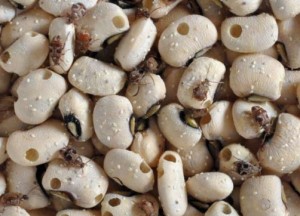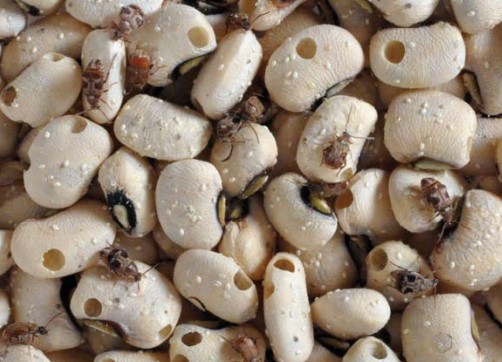Focus on research in post-harvest storage of cowpea in Burkina Faso
By Antoine Sanon (University of Ouagadougou, Burkina Faso), Clémentine Dabiré (Laboratoire d’entomologie agricole de Kamboinsé, Burkina Faso), and Dieudonné Baritbusa and Larry Murdock (Purdue University, USA)

This post is part of the ADM Institute’s #PreventPHL blog campaign, following up on the First International Congress on Postharvest Loss Prevention. To read more posts in the series, click here.
Cowpea, Vigna unguiculata (L.) Walp. Because of its high content in protein, is an important food legume in West Africa. Unfortunately, the seeds are destroyed by beetles of the Bruchidae family among which Callosobruchus maculatus Fab. is the most damaging species. An efficient post-harvest management of crops could significantly contribute to food security by improving food quality and increasing farmers’ incomes. In Burkina Faso, we have undertaken studies to understand the problem and find effective protection of cowpea during storage. This allowed us initially to study comprehensively the bio-ecology of Coleoptera Bruchidae in different ecological zones of Burkina Faso and the impact on seed storage. Insects begin infesting cowpea in fields and continue their action in the storage structures in which the harvested crops are stored. Losses from 10 to 100% are observed every year especially when unsuitable storage methods are used. Thus many producers of cowpea used large amounts of insecticides in order to keep their cowpea protected. In fact, those who manage to keep their cowpea in good quality through long storage periods can sell at better prices and thus get a more important outcome from cowpea marketing. To address the multiple disadvantages of the use of synthetic insecticides in food commodities, we began researching alternative solutions.
The proposed and tested solutions included:
- Biological control by releases of bruchid parasitoids in stores during early cowpea storage
- Use of insecticides and repellent plants, inert materials as well as vegetable oils
- Exposure of cowpea seeds to sun in order to kill insects by heat
- Hermetic storage using various airtight containers

 Today, the most effective and most promising technology is hermetic storage using triple bagging. This technology effectively tested since 2007 in 200 villages in Burkina Faso in the Purdue Improved Cowpea Storage (PICS) project has since been extended to the whole country and especially in areas of high cowpea production. The availability of PICS bags technology has also been addressed so that the PICS bags are now available and widely known by cowpea producers who also use them to store other legumes and cereals. PICS bags, simple for use and highly effective seem to be well suited to the needs of farmers. Effective post-harvest management requires the development of efficient technologies, simple, and easily adopted by users. Training of stakeholders including technology developers, extension technicians, and producers is also essential for sustainability of post-harvest management. After several years of research in the field of post-harvest preservation, we have achieved results and developed expertise that can be valued in Africa and even throughout the world. Therefore, we have created a degree course at the University of Ouagadougou (Burkina Faso) to train students at master’s and Ph.D. levels in the field of post-harvest management since 2014. This training program aims to strengthen capacity building for seniors through applied research in West Africa, to enable the establishment of a network of specialists capable of solving post-harvest problems and save food crops for food security in Africa.
Today, the most effective and most promising technology is hermetic storage using triple bagging. This technology effectively tested since 2007 in 200 villages in Burkina Faso in the Purdue Improved Cowpea Storage (PICS) project has since been extended to the whole country and especially in areas of high cowpea production. The availability of PICS bags technology has also been addressed so that the PICS bags are now available and widely known by cowpea producers who also use them to store other legumes and cereals. PICS bags, simple for use and highly effective seem to be well suited to the needs of farmers. Effective post-harvest management requires the development of efficient technologies, simple, and easily adopted by users. Training of stakeholders including technology developers, extension technicians, and producers is also essential for sustainability of post-harvest management. After several years of research in the field of post-harvest preservation, we have achieved results and developed expertise that can be valued in Africa and even throughout the world. Therefore, we have created a degree course at the University of Ouagadougou (Burkina Faso) to train students at master’s and Ph.D. levels in the field of post-harvest management since 2014. This training program aims to strengthen capacity building for seniors through applied research in West Africa, to enable the establishment of a network of specialists capable of solving post-harvest problems and save food crops for food security in Africa.
References
Sanon A, Ouedraogo AP, Tricault Y, Credland PF, Huignard J. 1998. Biological control of Bruchids in cowpea stores by release of Dinarmus basalis (Hymenoptera: Pteromalidae) adults. Environmental Entomology 27 (2): 717-725.
Sanon A, Garba M, Auger J, Huignard J. 2002. Analysis of the insecticidal activity of methylisothiocyanate on the Coleoptera Bruchidae Callosobruchus maculatus and its parasitoid Dinarmus basalis (Pteromalidae). Journal of Stored Products Research 38: 285-295.
Sanon, A., Dabiré, L.C.B., Ouédraogo, A.P., Huignard, J., 2005. Field occurrence of bruchid pests of cowpea and associated parasitoids in a sub humid zone of Burkina Faso: importance on the infestation of two cowpea varieties at harvest. Plant Pathology Journal 4, 14-20.
Sanon A, Dabiré-Binso LC, Ba N M, 2011. Triple-bagging of cowpeas within high density polyethylene bags to control the cowpea beetle Callosobruchus maculatus F. (Coleoptera: Bruchidae). J. Stored Product Research, 47: 210-215.
Sanon A, Ba N M, Dabiré-Binso LC, Nébié, RCH, Monge JP, 2011. Side effects of grain protectants on biological control agents: How Hyptis plant extracts affect parasitism and larval development of Dinarmus basalis. Phytoparasitica, 39:215–222.
The blog entries in this #PreventPHL series are by students and members of the PHL Prevention community of practice. The opinions expressed are those of the individual authors and do not necessarily reflect the position of the ADM Institute. In addition, none of the statements should be considered an endorsement of any person, product, or technique by the ADM Institute.
